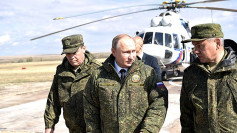The newest air superiority fighter of the U.S. Air Force now under development will be super stealthy, super smart -- and super expensive.
This new beast named "Penetrating Counter Air" (PCA), apparently for want of a better name, is expected to cost at least $300 million per plane. This compares to the current price of more than $100 million for a Lockheed Martin F-35 Lightning II stealth jet, which was derided as the world's most expensive toy back in the day.
PCA is a sixth-generation fighter that will replace the Lockheed Martin F-22 Raptor and the McDonnell Douglas F-15 C/D Eagle in the air-to-air combat role. A number of incredible features are being touted for the PCA. The most stunning of these technologies is a laser gun that can both shoot down enemy aircraft and missiles, as well as defend against enemy missiles.
These incredible bells and whistles come at a price and the Congressional Budget Office (CBO) estimates they all add up to $300 million per fighter. CBO said its estimate is based on two factors.
First, is that PCA will improve on the current capabilities of the Lockheed Martin F-35 and F-22 Raptor stealth jets when it comes it comes to range, payload, and stealth. Second, these new capabilities will take more time and money than anyone currently expects.
PCA remains a concept and remains undersigned. Current projections call for the Air Force to acquire 414 PCAs starting 2028. The fighter should enter service in 2030.
CBO, however, remains cautious about these timelines based on bitter past experience with the F-22 and F-35. It reported that in light of the long development times associated with F-22s and F-35s ... "that projection of the PCA aircraft's delivery schedule may be optimistic."
CBO also believes the Air Force might end-up looking for a cheaper alternative given PCA's hefty price tag. It said the Air Force might decide the PCA's cutting-edge design is unaffordable and instead opt to purchase more F-35As.
Buying hundreds of more F-35s in place of the PCA will save billions of dollars per year, said CBO. Peak annual savings on the procurement of more F-35A's is estimated at $6 billion in 2033.
The Air Force still hasn't selected a developer for the PCA, which is also known as Next-Generation Air Dominance (NGAD). In February, Brig. Gen. Alexus G. Grynkewich, Deputy Director, Global Operations, said the Air Force hopes to see PCA in operational service by 2030.
In2017, Gen. Grynkewich said a realistic timeline is somewhere around 2028 with key investments in some key technology areas, you'd be able to have some initial operational capability of a penetrating counter air capability.
He said that instead of having an argument over what a sixth gen fighter does, it's more productive to talk about the key attributes of the fighter the Air Force needs to gain and maintain air superiority in 2030.
He said the Air Force is looking at integrating advanced, cutting edge technologies like directed energy weapons (or lasers) in the initial version of PCA or a future block upgrade. Unwilling to repeat past mistakes, the Air Force doesn't want to delay PCA so a particular sensor or weapon can mature. PCA might not resemble a traditional fighter jet, he said but will be something much more than that.






